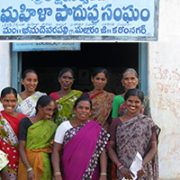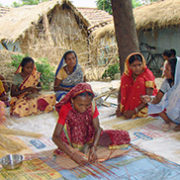Archive | Blog RSS feed for this section
Water
 Urban development
Urban development
 Finance sector development
Finance sector development
 Industry and trade
Industry and trade
 Health
Health
 Finance sector development
Finance sector development
 Economics
Economics
 Economics
Economics
 Information and Communications Technology
Information and Communications Technology
 Energy
Energy

The water challenge: international trade to the rescue

In many parts of the world, water availability is in decline and its quality is deteriorating. According to the World Bank, water scarcity, intensified by climate change, could come at a high price for some regions, costing as much as 6 percent of their gross domestic product. Tackling the water challenge is crucial to unlocking poverty eradication, prosperity, ecosystems preservation, and gender equality. As such, water security is a fundamental element of a sustainable development agenda. The United Nations Sustainable Development Goals recognized this by introducing a dedicated water goal (“SDG 6”) that seeks to “ensure availability and sustainable management of water and sanitation for all.”
Overcoming Asia’s housing challenge

Asia is urbanizing rapidly. Currently, about half of all of its residents live in urban areas, and the number of urban residents in Asia is expected to reach 3.3 billion by 2050. The Asian Development Bank Institute (ADBI) estimated that at the current urbanization rate, 127,000 people are added to urban centers every day in Asia.
Bridging the “missing middle” between microfinance and SME finance in South Asia

With financial inclusion finding a place in the international policy agenda, many developing countries are facilitating the development of their microfinance sectors. However, not enough attention has been paid to carving out a route for microfinance borrowers who outgrow microfinance, requiring loan sizes higher than the upper threshold of microcredit, still too small to avail of small and medium-sized enterprise (SME) credit from commercial banks. Other small enterprises that are unbanked also have needs unmet by microfinance institutions (MFIs) or commercial banks.
Exploring the trade–urbanization nexus in developing economies: evidence and implications

Modern humans have been increasingly concentrated in cities. The United Nations forecasts that 60% of the world’s population will live in urban areas by 2030. Regional multilateral institutions such as the Development Bank of Latin America and the Asian Development Bank have stepped up their efforts to support the urban sector and to collaborate on comparative studies of urbanization.
The cost of being obese

When we talk about the cost of being obese, many people will imagine the personal spending due to obesity, e.g. special clothing, housing, and transportation that may be different from the requirements of non-obese people, or even the medical expenses arising from obesity-related illnesses. Some people may also consider the cost of becoming obese, such as excessive consumption of high-calorie foods and sweetened beverages.
Assessing policies to promote financial inclusion, regulation, and education in emerging Asia

Financial inclusion has been receiving increasing attention for its potential to contribute to economic and financial development while fostering more inclusive growth and greater income equality. There are numerous arguments in favor of increasing financial inclusion, and a large body of evidence shows that increased financial inclusion can significantly reduce poverty and boost shared prosperity. Greater access to financial services by households can help smooth consumption, ease cash shortages, and increase savings for retirement and other needs, although the evidence on microfinance is less positive.
Are financial statements effective in evaluating the creditworthiness of small and medium-sized enterprises?

The credit risk database (CRD) was established in March 2001 as a membership organization to collect financial statements, some nonfinancial information, and default information of small and medium-sized enterprises (SMEs) in Japan. CRD members are composed of all credit guarantee corporations (CGCs) in Japan, government-affiliated or private financial institutions, and so on.
Rethinking the small and medium-sized enterprise financing model and the role of commercial banks

At a time of much global uncertainty and economic slowdown, building internal resiliency is becoming increasingly important. Small and medium-sized enterprises (SMEs) play a central part in this, via its role in enhancing economic dynamism and creating employment opportunities in a country. SMEs usually make up a huge proportion of all businesses around the world. In Thailand, they account for as much as 99.7% of all enterprises, hire 80.3% of total labor force, and contribute 26.3% of export value.
Going digital in the Pacific: lessons from Samoa’s online firms

More than ever before, Pacific firms are moving online. Will this increase e-commerce? This online activity is particularly good news in 2016, as the Pacific has witnessed an 8.2% jump in tourism arrivals. According to Pacific niche exporters, tourists constitute the majority of their overseas customers, often by visiting the seller’s website after they return home to seek out more information or re-order souvenirs.
Belling the cat: financing solar renewable energy projects

World energy demand is forecasted to grow by nearly one-third between 2015 and 2040. A large share of this increase will be from the power sector, and the global demand for electricity is likely to increase by more than 70%, leading to a 16% increase in energy-related carbon dioxide (CO2) emissions by 2040. Despite the diplomatic success of the Conference of the Parties (COP) 21, it is clear that the current pledges by various countries in the form of Nationally Determined Contributions fall way short of the “well below 2-degrees Celsius” goal agreed to by world leaders in Paris.


Search
Subscribe / Connect to Asia Pathways
Subjects
- Agriculture and natural resources
- Blog
- Capacity development
- Climate change
- Economics
- Education
- Energy
- Environment
- Finance sector development
- Gender
- Governance and public sector management
- Health
- Industry and trade
- Information and Communications Technology
- Infrastructure
- Miscellaneous
- Population
- Poverty
- Private sector development
- Regional cooperation and integration
- Sanitation
- Social development and protection
- Transport
- Uncategorized
- Urban development
- Video Blog
- Water
Recent Posts
- Facilitating high-speed rail knowledge transfer between Japan and India
- Artificial intelligence: A new driver for inclusive growth and development?
- Increasing trust in cross-border e-commerce and artificial intelligence
- Enhancing access to maternal and newborn healthcare in developing Asia
- Can electric vehicles lead the way to a sustainable future?




Recent Comments